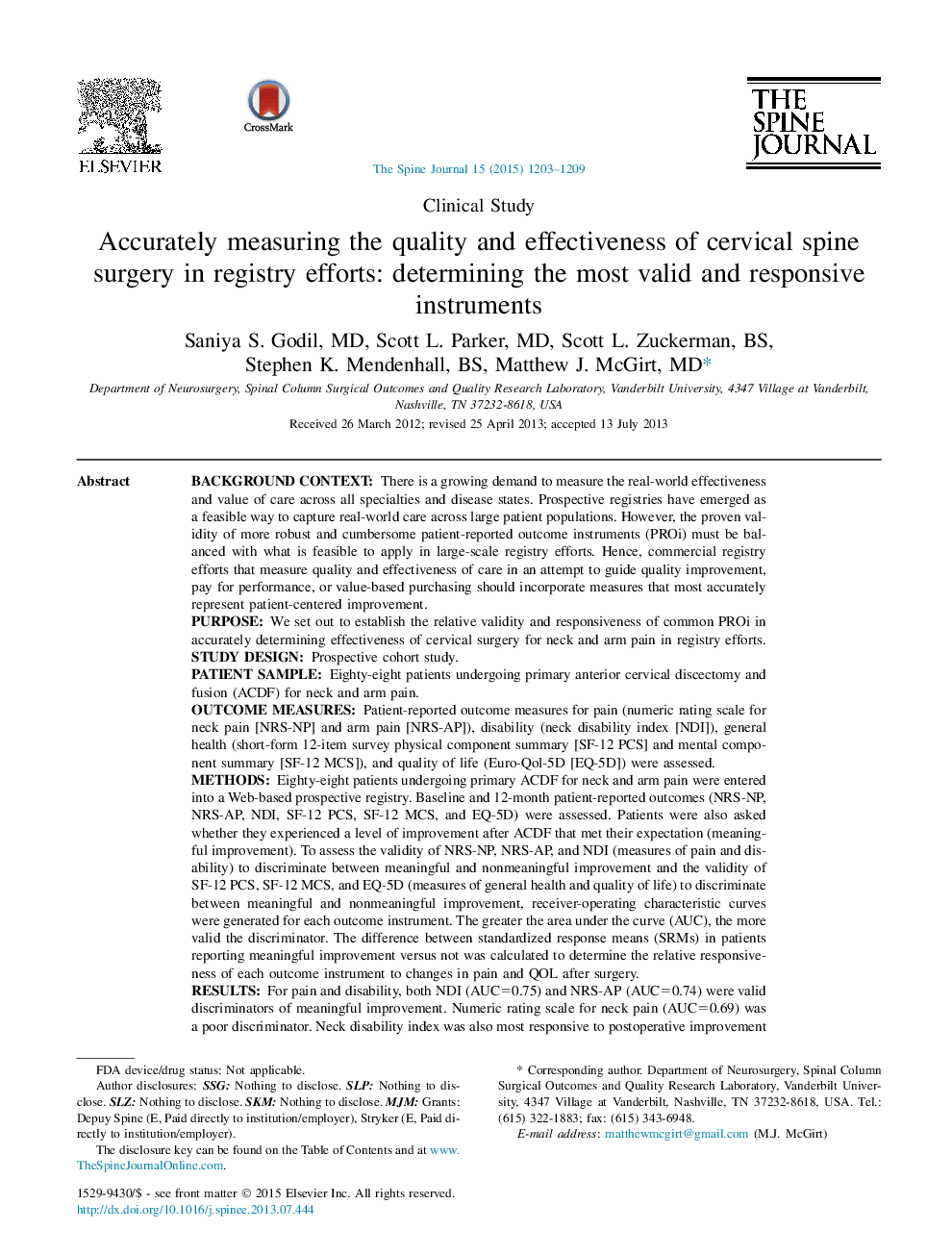| کد مقاله | کد نشریه | سال انتشار | مقاله انگلیسی | نسخه تمام متن |
|---|---|---|---|---|
| 6211877 | 1268561 | 2015 | 7 صفحه PDF | دانلود رایگان |
Background contextThere is a growing demand to measure the real-world effectiveness and value of care across all specialties and disease states. Prospective registries have emerged as a feasible way to capture real-world care across large patient populations. However, the proven validity of more robust and cumbersome patient-reported outcome instruments (PROi) must be balanced with what is feasible to apply in large-scale registry efforts. Hence, commercial registry efforts that measure quality and effectiveness of care in an attempt to guide quality improvement, pay for performance, or value-based purchasing should incorporate measures that most accurately represent patient-centered improvement.PurposeWe set out to establish the relative validity and responsiveness of common PROi in accurately determining effectiveness of cervical surgery for neck and arm pain in registry efforts.Study designProspective cohort study.Patient sampleEighty-eight patients undergoing primary anterior cervical discectomy and fusion (ACDF) for neck and arm pain.Outcome measuresPatient-reported outcome measures for pain (numeric rating scale for neck pain [NRS-NP] and arm pain [NRS-AP]), disability (neck disability index [NDI]), general health (short-form 12-item survey physical component summary [SF-12 PCS] and mental component summary [SF-12 MCS]), and quality of life (Euro-Qol-5D [EQ-5D]) were assessed.MethodsEighty-eight patients undergoing primary ACDF for neck and arm pain were entered into a Web-based prospective registry. Baseline and 12-month patient-reported outcomes (NRS-NP, NRS-AP, NDI, SF-12 PCS, SF-12 MCS, and EQ-5D) were assessed. Patients were also asked whether they experienced a level of improvement after ACDF that met their expectation (meaningful improvement). To assess the validity of NRS-NP, NRS-AP, and NDI (measures of pain and disability) to discriminate between meaningful and nonmeaningful improvement and the validity of SF-12 PCS, SF-12 MCS, and EQ-5D (measures of general health and quality of life) to discriminate between meaningful and nonmeaningful improvement, receiver-operating characteristic curves were generated for each outcome instrument. The greater the area under the curve (AUC), the more valid the discriminator. The difference between standardized response means (SRMs) in patients reporting meaningful improvement versus not was calculated to determine the relative responsiveness of each outcome instrument to changes in pain and QOL after surgery.ResultsFor pain and disability, both NDI (AUC=0.75) and NRS-AP (AUC=0.74) were valid discriminators of meaningful improvement. Numeric rating scale for neck pain (AUC=0.69) was a poor discriminator. Neck disability index was also most responsive to postoperative improvement (SRM difference 0.78), followed by NRS-AP (SRM difference 0.59) and NRS-NP (SRM difference 0.46). For general health and quality of life, SF-12 PCS (AUC=0.79) was the only valid discriminator of meaningful improvement. Euro-Qol-5D (AUC=0.68) and SF-12 MCS (AUC=0.44) were poor discriminators. Short-form 12 physical component summary (SRM difference 1.08) was also most responsive compared with EQ-5D (SRM difference 0.89) and SF-12 MCS (SRM difference 0.01).ConclusionsFor pain and disability, NDI is the most valid and responsive measure of improvement after surgery for neck and arm pain. Numeric rating scale for neck pain and NRS-AP are poor substitutes for NDI when measuring effectiveness of care in registry efforts. For health-related quality of life, only SF-12 PCS could accurately discriminate meaningful improvement after cervical surgery and was found to be most valid and responsive. Large-scale registry efforts aimed at measuring effectiveness of cervical spine surgery should use NDI and SF-12 to accurately assess improvements in pain, disability, and quality of life.
Journal: The Spine Journal - Volume 15, Issue 6, 1 June 2015, Pages 1203-1209
